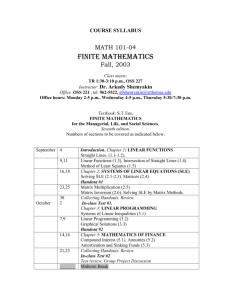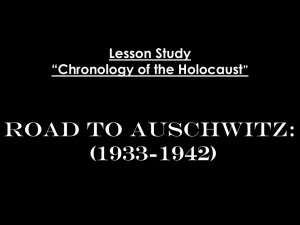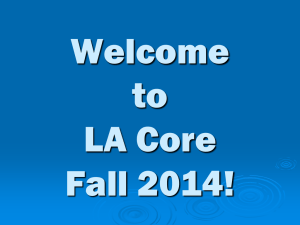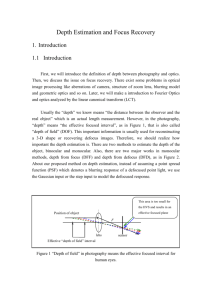the PPT file
advertisement
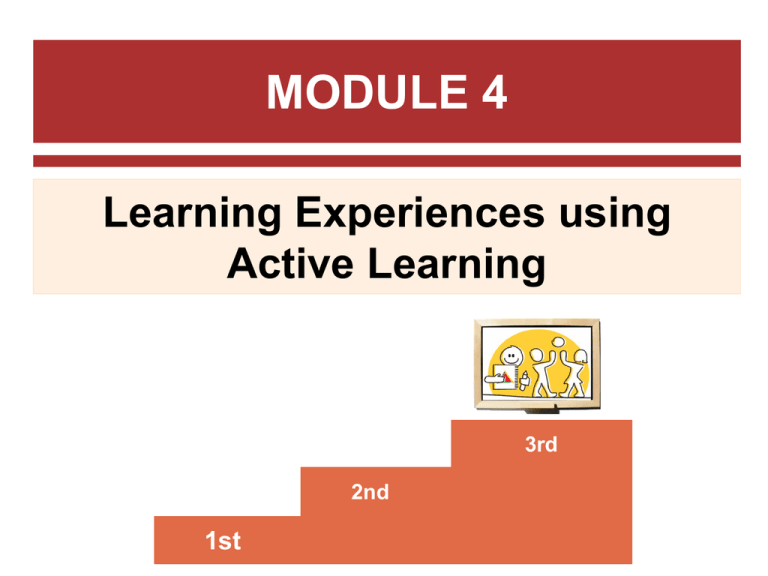
MODULE 4 Learning Experiences using Active Learning 3rd 2nd 1st The Backward Design Define Learning Objectives 1st Define Evidences of Learning and Assessment tasks 2nd Plan Learning Experiences 3rd Learning Objectives • How to create a lesson plan? • How to engage students in a course? • What is the professor’s role in a learner-centered classroom? • What is the purpose of using Active Learning? • How to apply Active Learning to a course? From Big Ideas to Lesson Plans What students should be able to What students should be able to know know and do by the end of the and do by the end of the course? course? BIG IDEA Learning Nature Objectives Learning Goals of the Experiences Content Content Plan LESSON PLANS Assessment Activities From Big Ideas to Lesson Plans BIG IDEA Learning Nature Objectives Goals of the Content Content Plan What to teach? Main Idea behind the concepts and skills you want to teach How would you summarize this concept in one sentence? From Big Ideas to Lesson Plans Nature of the Content Perform Analyze Create Learning LESSON PLAN experiences Listen Talk What students should do What is the best way to learn this concept or skill? to provide this See Other … experience? Create a context that will reproduce / illustrate the nature of the content Give students a role (thinking or acting) in this context Debrief: students should talk and reflect on the experience Lesson Plan Directions on how to help students to achieve the desired results Current knowledge and skills Lesson Plan Desired knowledge and skills Where to start? Who your students are? • What are the course objectives? • What do your students already know? • What is the gap? How to bridge it? To From First, learn about your students! What do they Know? What do they Want to learn? What they should Learn? Then, create or adjust lesson plan to fulfill students’ needs! Components of a Lesson Plan The lesson plan will follow the same path from backward design! Course number and name OBJECTIVES: Big Ideas Topic & Context Learning Objectives ASSESSMENTS: Performance Tasks Other formative assessment activities LEARNING ACTIVITIES: Time Teaching Method Professor Instructions and Student Learning Activities Material and Resources Creating Learning Activities What students should do to achieve the desired results? “I hear, I forget I see, I remember I do, I understand” - Chinese Proverb Class activities should engage students! From “Understanding by Design”, Wiggins and McTighe Principles of LCT Shared power More development activities, teacher as facilitator Students more responsible for learning Evaluation promotes learning LCT strategies provide ways to engage students in active participation and to build their own understanding Less teacher control Less content coverage Less focus on teacher Less focus on grades Weimer, 2002 How to engage students? By using LCT! Teaching approaches that creates learning environments to engage students to construct understanding based on: Create meaning Solve problems Apply concepts Relevant to Perform authentic students tasks Real-life situations Knobloch & Ball, n.d.) What is the professor role in LCT environment? Professors should act as facilitators, encouraging students interaction and discussions Professors will: • Prepare more class activities -> Students will construct their knowledge • Prepare and give less lecture -> Interact more with students • Create environment for interaction -> Manage class discussions (http://academic.pgcc.edu/~wpeirce/MCCCTR/weimer.htm) LCT Approaches LCT strategies were grouped into three approaches: Which one should I use? It will depend on the learning experience needed to achieve the objective Active Learning Students should do more than simply listen to a lecture! Students should process and use the information in order to retain it Active Learning is “anything that involves students in doing things and thinking about the things they are doing” (Bonwell & Eisen, 1991) Why Active Learning? Why is it important? The amount of information retained by students declines substantially after ten minutes of listening (Thomas, 1972) Students need to be physically and mentally involved in class activities to learn Multiple Intelligences Learning requires multi-modal approaches! Why Active Learning? Why does it help students to learn? Students who actively engage with the material are more likely to recall information (Bruner, 1961) Provide immediate feedback, raise questions, and make students think, building understanding Different people learn in different ways (Multiple Intelligences) Active Learning Process A dynamic process! Multimodal delivery Knowledge Feedback Questions Application Student’s existing knowledge Professor as facilitator Understanding How to use Active Learning? Multi-modal delivery engages students in class activities that use multiple senses Social Visual Active Learning Verbal Real-time feedback Kinesthetic Active Learning: Visual Visual Instruction + Analysis Show students: • Videos • Demonstrations • Real objects • Graphs / Diagrams / Pictures • Animations / Flashes Use technology to present concepts: • Animations / Flashes • Simulation • 3D images Active Learning: Verbal Engaging Lectures! Story-telling Involving students in the story Teaching with enthusiasm Use: • Analogies/metaphors • Stories • Real-life examples Teaching with songs Active Learning: Verbal Humor Communicate meaning, relevance Connects! Student’s mind Teaching in chunks Previous experiences Break lessons down into lessons segments (~10 min) and processing time (~2 to 10 min) Active Learning: Social Peer-to-peer learning! Promotes Students’ interaction! In-class discussions • In pairs • With all students & professor as facilitator • Think-pair-share In-class debates Active Learning: Social Peer teaching or Collaborative Learning In-class small projects In-class small scenarios and discussion Active Learning: Social Brainstorming Concept mapping Ask students to create visual representations of models, ideas and relationship between concepts + share + discussion Student-led review sessions Active Learning: Real-time Feedback In-class writing One-minute Paper / Essay: • Student will summarize last or current class, and write questions to be clarified • Students will write down the key idea and what needs clarification Stump the professor Students will write down difficult questions about the content to ask the professor. The objective is to ask questions that the professor is not able to answer. Active Learning: Real-time Feedback Review Games Games can include matching, mysteries, and group competitions (jeopardy, bingo) Active Learning: Real-time Feedback Thumbs up / thumbs down / thumbs sideways or flash cards Ask students to agree disagree to a statement, problem solution and discuss their reasoning Use clickers to in-class quiz, student voting, opinion etc. Debriefing / reflection Active Learning: Kinesthetic Learning by doing! Use the body! Perform a task Build models Build Models Role-playing Perform or review concepts How to get started? What students should know and be able to do at the end of the class? Objectives & Learning Goals How would you summarize this concept in one sentence? What students should do to learn this concept or skill? It may require Active Learning, Inquiry Learning or Contextual Learning activities! Nature of the Content Learning experiences LESSON PLAN What specific activity professor could create that will provide students the right learning experience? What resources should be used? How to get started? A Nutrition Example Objectives & Learning Goals Nature of the Content Learning experiences • Listen • See Describe and explain the digestion process Digestion is a process; a sequence of events LESSON PLAN • Show pictures or video while lecturing • Talk about it • Peer-teaching, concept mapping • Get involved in the process • Build a model, role-play • Review • Quiz Process / digest the information Use of visual aids xx x x Story-telling xx x Involve students in the story Teaching with enthusiasm Use of songs x xx x x xx x Explain / communicate x x x xx xx Practice application xx x x x x x Get other student's view Develop a skill Connect / associate Build confidence Draw conclusions Generate ideas 1 Review / Reinforce Memorize / Recall Activity Clarify / internalize 2 Create interest, present idea Outcomes of each activity Desired Outcomes / Objectives x x xx x x Memorize / Recall 2 Use of Humor xx x Communicate meaning, relevance x Teach in chunks In-class discussion x x In-class debates xx Peer teaching xx x x xx x x xx x x x x x x xx xx x x x x Build confidence Draw conclusions xx x x x xx xx xx Get other student's view Develop a skill Practice application x Connect / associate xx Explain / communicate Generate ideas Review / Reinforce 1 Process / digest the information Clarify / internalize Activity Create interest, present idea Outcomes of each activity Desired Outcomes / Objectives x Clarify / internalize Process / digest the information Review / Reinforce Generate ideas Explain / communicate Draw conclusions 2 In-class small projects x x x xx xx x xx In-class small scenarios discussion x x xx xx xx x xx Brainstorming x Concept mapping Students presentation x xx xx xx x xx Connect / associate Practice application Develop a skill Get other student's view 1 Build confidence Memorize / Recall Activity Create interest, present idea Outcomes of each activity Desired Outcomes / Objectives x xx x xx xx x x xx x xx xx xx xx x x 2 Activity Debrief, reflection xx Review games xx xx xx x x x xx Thumbs up/down x x xx Quizzes x xx x x x Draw conclusions xx x x x x Get other student's view Develop a skill Practice application Connect / associate Build confidence Explain / communicate 1 Generate ideas Review / Reinforce Stump the professor Process / digest the information In-class writing Clarify / internalize Memorize / Recall Create interest, present idea Outcomes of each activity Desired Outcomes / Objectives x x x xx Outcomes of each activity x xx xx xx x xx xx xx xx Get other student's view x Role-playing x Develop a skill x x Practice application x xx Connect / associate x Build confidence x Explain / communicate Perform a task Generate ideas Process / digest the information xx Review / Reinforce Clarify / internalize x Memorize / Recall x Activity Create interest, present idea Build models 2 Draw conclusions Desired Outcomes / Objectives 1 x x Bottom line: different activities will lead to different outcomes! Depending on the nature of the task, different outcomes can be achieved. Is my lesson plan engaging and effective? Is it providing students a path to achieve the objectives? Where is it going? Why? Hook the students and Hold their attention Equip students with opportunities to Experience and Explore the big ideas Provide opportunities to students to Reflect, Rethink and Revise Evaluate work and their progress Tailor to students’ needs, interests and styles Organize activities for maximum engagement and effectiveness Summary BIG IDEA From Big Ideas to Lesson Plans! Learning Nature Objectives Learning Goals of the Experiences Content Content Plan LESSON PLANS Assessment Activities Summary Learn about your students Plan activities that will bridge the gap Current knowledge and skills Lesson Plan Desired knowledge and skills Write your Lesson Plan Summary Which activities? Activities are effective and engaging? Summary Active Learning Social Visual Active Learning Verbal Real-time assessments Kinesthetic Learning Objectives • How to create a lesson plan? • How to engage students in a course? • What is the professor’s role in a learner-centered classroom? • What is the purpose of using Active Learning? • How to apply Active Learning to a course? References • Understanding, Unpacking Standards, Big Idea, Essential Questions Wiggins, Grant and McTighe, Jay. Understanding by Design. 2nd Edition. ASCD, Virginia, 2005. • Multiple Intelligences • http://en.wikipedia.org/wiki/Theory_of_multiple_intelligences • http://www.shapingyouth.org/blog/?p=2071 • Active Learning: Creating Excitement in the classroom, by Charles C. Bonwell, Ph.D. • Center for Teaching, Learning and Technology website, by Kathleen McKinney (http://www.cat.ilstu.edu/additional/tips/newActive.php) References • Review and Summary of Learner-Centered Teaching by Maryellen Weimer (http://academic.pgcc.edu/~wpeirce/MCCCTR/weimer.htm) • Active Learning Strategies: • http://www.phy.ilstu.edu/pte/311content/activelearning/activelearning.html • http://activelearning.uta.edu/FacStaff/ALtechniques.htm • http://www.vcu.edu/cte/resources/active_learning.htm • http://www.thiagi.com/interactive-lectures.html



